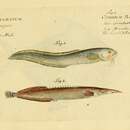Diseases and Parasites
provided by Fishbase
Capillaria Infestation. Parasitic infestations (protozoa, worms, etc.)
Trophic Strategy
provided by Fishbase
Occurs in medium to large-sized rivers (Ref. 12975). Found in lowland wetlands and peats. Recorded as having been or being farmed in rice fields (Ref. 119549).
- Recorder
- Arlene G. Sampang-Reyes
Morphology
provided by Fishbase
Dorsal spines (total): 14 - 20; Dorsal soft rays (total): 52 - 56; Analspines: 3; Analsoft rays: 50 - 54
Migration
provided by Fishbase
Potamodromous. Migrating within streams, migratory in rivers, e.g. Saliminus, Moxostoma, Labeo. Migrations should be cyclical and predictable and cover more than 100 km.
Life Cycle
provided by Fishbase
Produces a minimum of 1000 eggs (Ref. 1672).
Diseases and Parasites
provided by Fishbase
Paracamallanus Infection 1. Parasitic infestations (protozoa, worms, etc.)
Diseases and Parasites
provided by Fishbase
Rhyncopharynx Infestation. Parasitic infestations (protozoa, worms, etc.)
Diseases and Parasites
provided by Fishbase
Cotylogonoporum Infestation. Parasitic infestations (protozoa, worms, etc.)
Diseases and Parasites
provided by Fishbase
Allogomtiorema Infestation. Parasitic infestations (protozoa, worms, etc.)
Diseases and Parasites
provided by Fishbase
Camallanus Infection 6. Parasitic infestations (protozoa, worms, etc.)
Diseases and Parasites
provided by Fishbase
Allocreadium Infestation 5. Parasitic infestations (protozoa, worms, etc.)
Diseases and Parasites
provided by Fishbase
Bacterial Infections (general). Bacterial diseases
Diagnostic Description
provided by Fishbase
Body with series of obliquely oriented bars (Ref. 39392). Dorsal and anal fins with a row of isolated spines followed by a long continuous soft portion, both fins extending to but not confluent with caudal fin. Pelvic fins absent. Caudal fin rounded (Ref. 4792).
Biology
provided by Fishbase
Adults occur in medium to large-sized rivers (Ref. 12975). Found in lowland wetlands and peats. Uncommonly seen in aquarium trades (Ref. 57235).
Importance
provided by Fishbase
fisheries: minor commercial; aquarium: commercial
Lesser spiny eel
provided by wikipedia EN
The lesser spiny eel, Macrognathus aculeatus, is a Southeast Asian tropical freshwater fish belonging to the family Mastacembelidae.[2] They are uncommonly found in aquaria.
Physical characteristics
The eel has an upper-body that is yellow, a black line down the middle and the lower-body is usually a mix of white and brown. Along the backbone of the eel, the dorsal fin is preceded by numerous isolated small spines that can be raised, giving them the name. The dorsal fin also has many prominent eyespots along the base. There are many different variations of the Spiny Eel. They can grow up to be 14 inches long (35 centimeters), but are usually smaller.
Distribution and habitat
This fish is found in Southeast Asia from locations such as Malaysia, Thailand, Borneo, and Indonesia. They occur in medium to large-sized rivers. They are found in lowland wetlands and peats.[1] These fish are an uncommon aquarium fish.[1]
Behavior
They're crepuscular and nocturnal burrowers. They may prey on small fish.
References
Jennings, Greg. (2006). 500 Freshwater Aquarium Fish. Firefly Books.

- license
- cc-by-sa-3.0
- copyright
- Wikipedia authors and editors
Lesser spiny eel: Brief Summary
provided by wikipedia EN
The lesser spiny eel, Macrognathus aculeatus, is a Southeast Asian tropical freshwater fish belonging to the family Mastacembelidae. They are uncommonly found in aquaria.
- license
- cc-by-sa-3.0
- copyright
- Wikipedia authors and editors

